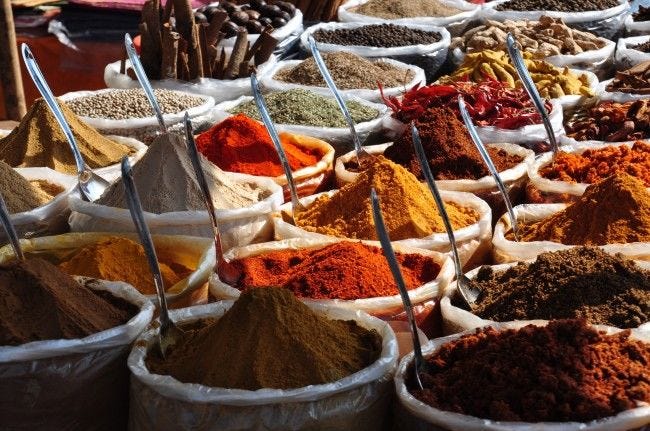Amid the general gloom of the moment (need we count the ways?) I thought something fun might not be amiss. Like a little jig on the edge of the abyss.
So let’s talk food. Let’s talk flavor. Specifically, the tiny flavor bombs called spices.
I learned last week from an episode of the Splendid Table podcast about a new wave of spice merchants, people like Sana Javeri Khan of Diaspora Co and Ethan Frisch of Burlap & Barrel. These folks are forging new paths in the largely entrenched world of the spice trade.
Here’s the world’s shortest history lesson: largely a colonial legacy, the spice trade’s economically-exploitative structures changed little after (for example) India’s independence, with Indians simply slotting into the roles formerly held by Brits. Unchanged were the pitifully low wages for farmers, the absurd numbers of middlemen (as many as ten), and generally low quality of end-market spices.
I know this isn’t fun yet, but we’re nearly there.
As I learned from listening to Khan, the average age of the commodity spices that live in most spice racks is between 5 and 10 years old. But even if they arrived fresher, many or most spices aren’t that great quality to begin with. That’s because everything from cloves to black pepper to cardamom gets treated purely as a commodity crop, largely undifferentiated from batch to batch, variety to variety.
As it turns out, there are many, many varieties of some spices, whether due to farming technique, growing location (what the wine folks call terroir) or genetic variance.
I’ve certainly noted how much more potent Afghan saffron can be compared to the Spanish stuff, and appreciated the fruity, aromatic kick of high quality black pepper. But I’ll be honest, I had no idea there were hundreds of kinds of turmeric, or even that turmeric had an especially notable flavor to begin with. That’s embarrassing for someone who’s spent considerable time in South Asia and learned to cook a wide array of Indian and Nepali dishes (in which turmeric is near-omnipresent).
It may be embarrassing, but it’s also an opportunity for revelation. That’s the word I’d use—revelatory—hearing about Khan’s work with Diaspora Co, a company that placed its initial bets on the quality of a regeneratively farmed turmeric variety because of its exceptional flavor (“like marigolds and sunshine).” That bet proved so successful that they’ve since expanded to some 30 South Asian spices.
Just hearing about that turmeric caused a dam to breach in my brain. Realization came flooding in: what about all the other spices? They too have different cultivars, varietals, growing regions. Exceptional quality is possible all around. It’s out there. Merchants like Khan and Frisch are not only making that kind of quality accessible to anyone prepared to throw down $10 instead of $5.99 on a spice jar, but they’re doing so in a way that supports farmers to have a truly sustainable livelihood and that preserves genetic diversity. Now if that isn’t some good, clean, spicy fun, I don’t know what is.
So. Armed with a new awareness of what’s out there, I did what any sane spice lover would: ordered a dozen or so spices from the two companies mentioned above. (That was me showing restraint — it could easily have been three dozen. We can live entirely off spices this month, right, baby?).
When they arrive—any day now—you can bet I’ll be donning my mad scientist gear, rolling up my sleeves, and breaking out the 45 lb mortar and pestle1. We’ll see what fermented white pepper from Indonesia does for a congee; how Afghani wild cumin gets along with lamb from my neighbor’s farm; and what West African locust beans (heard of ‘em? I sure hadn’t) have to teach me about umami. It’s about to get wicked intricate, as a Vermonter once said.
I’ll be reporting my findings here. Thanks to my friend Bettina for encouraging me to document the experiments to come.
In the meantime, remember: when life gives you lemons, stick them in a jar with salt, forget about them for several months, and then make a cumin-mint-saffron-preserved-lemon cocktail.
See you in kitchen.
A footnote for a mortar and pestle? Oh yeah, we’re doing it. That thing’s a prized possession. I found it at a Thai grocer in Manhattan’s Chinatown two decades ago, lugged it home on the subway, and it’s lived with me in at least three time zones.



